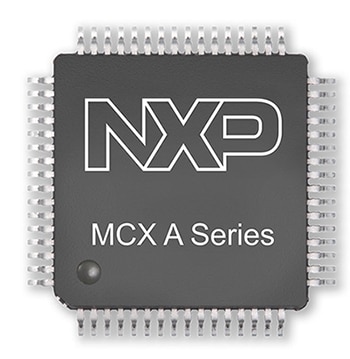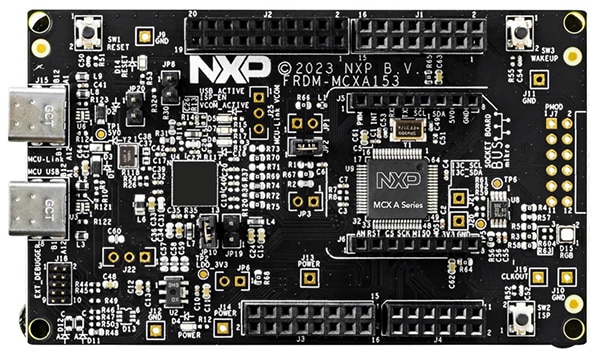NXP Offers an Arm® Cortex®-M33 Development Ecosystem
Contributed By DigiKey's North American Editors
2024-05-09
Arm® Cortex®-M33 core processors are a family of low-power, high-performance microcontrollers (MCUs) that offer enhanced security and digital signal processing capabilities. They are suitable for a wide range of IoT and embedded applications, but designing products with these MCUs can be challenging, especially for developers who are not familiar with the Arm architecture. NXP Semiconductors, a leading provider of Arm-based microcontrollers, aims to ease that challenge with its MCUxpresso development platform.
Arm's reduced instruction set computing (RISC) processor dominates in market segments such as smartphones and consumer electronics, where low power and high performance are crucial.
The Cortex-M33 processors are designed to be energy-efficient and offer low-power modes that reduce active and sleep current consumption, and can drive a wide range of applications such as industrial control, smart home, wearable devices, and IoT. They provide developers with a high degree of flexibility and scalability, but also require careful optimization to achieve the ideal trade-off between performance, power consumption, and footprint.
Cortex-M33 MCUs support the Arm Embedded Application Binary Interface (EABI), which ensures binary compatibility with other Cortex-M processors, allowing them to run existing Cortex-M code without modifications. This compatibility provides access to existing software tools, libraries, and middleware.
NXP's MCX portfolio
NXP is one of the top manufacturers of Arm-based MCUs, including general purpose and auto-industry-specific products. It has positioned its MCX portfolio as the foundation for power-efficient edge devices across the industrial and IoT markets, with expanded scalability and breakthrough product capabilities.
MCX MCUs comprise two distinct product lines:
- MCX N Series of industrial and IoT MCUs featuring dual Cortex-M33 cores operating up to 150 MHz and featuring the company's eIQ® Neutron Neural Processing Unit (NPU) for machine learning (ML) acceleration. These high-performance, low-power MCUs incorporate intelligent peripherals and accelerators, providing multitasking capabilities and efficient performance.
- MCX A Essential Series, a product line of single core Cortex-M33 MCUs optimized to provide critical functionality for applications where advanced analog capabilities such as high-precision data converters, cost constraints, and fast time-to-market are key considerations.
This article will focus on the MCX A MCUs (Figure 1) and their development tools. The MCX A Series supports a large range of applications across various markets, including industrial communications, smart metering, automation and control, sensors, and low-power and battery-powered devices. With a common core and peripherals, developers can take advantage of simplified software development, eased migration, and upgrades.
 Figure 1: Representation of NXP's MCX A Series microcontroller. (Image source: NXP)
Figure 1: Representation of NXP's MCX A Series microcontroller. (Image source: NXP)
Each MCX A Series device includes a selection of smart peripherals that are able to run independent of the CPU, enabling it to run at a lower frequency and with reduced power consumption. These peripherals enable designers to utilize a smaller package, simpler board design, and lower system bill of materials (BOM) costs.
Included peripherals are:
- Serial comms with built-in buffers, programmable data collection range, and DMA
- Mixed signal analog-to-digital converter (ADC)
- Digital-to-analog converter (DAC)
- Operational amp with built-in intelligence for averaging and peak detection
- FlexPWM (pulse width modulator) with dead time control and encoder for motor applications
The MCX A MCUs also feature a power management unit (PMU) that enables dynamic voltage and frequency scaling (DVFS), and adaptive power control (APC) to optimize power consumption according to workload and operating conditions. Devices include 64 KB or 128 KB of flash memory and 16 KB or 32 KB of SRAM—all RAM data can be retained down to deep power down mode.
A 4 KB Low-Power Cache Controller (LPCAC) attached to the Cortex-M33 code bus ensures data and instructions can be available with a low latency. Bus availability for other peripherals is improved as the processor performance can be decoupled from system memory performance. This feature can help developers achieve the best I/O and processing performance for sensing and control applications.
MCX A devices operate at 48 MHz for the A14x Series and 96 MHz for the A15x Series. MCX A uses a capless LDO power subsystem, which can operate from 1.7 V to 3.6 V. The devices feature low power consumption in various modes:
- 59 µA/MHz (3 V, at +25°C) in active mode running Coremark from internal flash
- 6.5 µA Deep Sleep, 10 µs wake-up with full SRAM retention, 3 V at +25°C
- Less than 400 nA in Deep Power down with 2.78 ms Wake
MCX A devices include a full-speed USB device controller with onboard PHY, enabling connectivity to PCs and other devices. The USB subsystem features in-system programming (ISP) via the boot ROM, and products can be field updated using the USB interface.
Depending on the model, developers can take advantage of 26 to 52 general purpose input/output (GPIO) pins. Serial communication interfaces include one I²C, two SPI, and three UARTs. Included are three 32-bit timers that can generate complementary PWM pairs with deadband insertion, along with one low-power timer. The supply voltage can range from 1.71 to 3.6 V, and the operating temperature is from -40°C to +125°C.
The A14x-Series MCXA143VLH, for example, has 52 GPIO pins and operates up to 48 MHz, with 128 KB flash memory and 32 KB of SRAM, in an LQFP64 package. The 15x-Series MCXA152VFT also has 52 GPIO pins and operates at up to 96 MHz, with 64 KB flash memory and 16 KB SRAM, in a QFN48 package.
Leveraging MCUXpresso
These MCUs provide balance between cost, performance, and power efficiency. With support for more GPIO pins, designers can leverage smaller packages and simpler board designs.
The series takes advantage of the MCUXpresso Developer Experience to smooth the development process with software, tools, and secure provisioning to accelerate design cycles and help developers create, debug, and optimize applications. The MCUxpresso platform includes:
- MCUxpresso IDE—an integrated development environment that supports code editing, compilation, debugging, and flash programming
- MCUxpresso Config Tools—a set of graphical tools that help developers configure the pins, clocks, peripherals, and security features
- MCUxpresso SDK—a software development kit that provides a collection of drivers, middleware, libraries, and examples
NXP development boards for the MCX A Series, including the FRDM-MCXA153 (Figure 2), are designed for rapid prototyping and development of applications using both the A14x and A15x microcontrollers.
 Figure 2: The FRDM-MCXA153 development board. (Image source: NXP)
Figure 2: The FRDM-MCXA153 development board. (Image source: NXP)
These boards are compact, allowing for easy integration into design prototypes. Industry-standard headers provide straightforward I/O access for rapid evaluation and fast prototyping. Expansion options like Arduino® Header, FRDM Header, Pmod™, and mikroBUS™ allow developers to readily add additional functionalities and components.
Other developer-friendly features include integrated open-standard serial interfaces, external flash memory, and an on-board MCU-Link debugger with CMSIS-DAP protocol. Developers can choose to work with either MCUXpresso for Visual Studio Code or Eclipse-based MCUXpresso IDE from NXP, or with IDEs from IAR and Keil that also offer safety certification.
NXP also provides an Application Code Hub (ACH) repository with high level software examples, code snippets and demos. These examples pair with the SDK and can be directly accessed from NXP's IDEs or through the ACH web interface.
Conclusion
NXP’s MCX A Series microcontrollers provide a low-cost, small-footprint solution for developers, with essential features and innovative power architecture that make them well-suited for a broad range of embedded applications such as smart metering, automation and control, and low power/battery powered devices. NXP’s microcontrollers, evaluation boards, and the MCUXpresso platform can help developers take advantage of advanced editing, compiling, and debugging features to innovate, optimize, and go to market.

Disclaimer: The opinions, beliefs, and viewpoints expressed by the various authors and/or forum participants on this website do not necessarily reflect the opinions, beliefs, and viewpoints of DigiKey or official policies of DigiKey.










